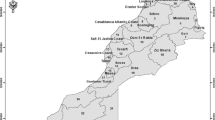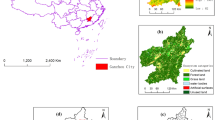Abstract
A comprehensive understanding of the multiple factors affecting ecosystem services (ESs) supply and demand balance is essential for effective ecosystem management and policy making. However, the importance of individual factors for ES balance is still unclear. Using Integrated Valuation of Ecosystem Services and Tradeoffs (InVEST) models and Structural Equation Modeling, I mapped the supply–demand balance of four types of ESs (carbon sequestration, water yield, soil conservation, and recreation) in Taihu Lake Basin, China, and quantified the causal relationships between multiple factors and ES balance. The results revealed spatial heterogeneity and imbalance in ES supply and demand in the basin, with the greatest imbalances in built-up city center areas. ES balance was influenced by multiple factors, but particularly normalized difference vegetation index (NDVI), elevation, precipitation, and human disturbance. For appropriate watershed management in the future, it is recommended that numbers of small-scale community parks in city centers be increased and that green space be expanded in the suburbs, implementing multi-objective ES management systems and step-by-step implementation plans, and optimizing the configuration of natural ecosystems by creating buffer strips for built-up areas. By carefully managing ES supply–demand balance and associated influencing factors, ecosystem status and human well-being in Taihu Lake Basin, and in other similar basins, can be substantially improved.







Similar content being viewed by others

Availability of data and materials
The datasets supporting the results of this article are available in the Suzhou Administrative Institution.
References
Bai Y, Zhuang CW, Ouyang ZY, Zheng H, Jiang MB (2011) Spatial characteristics between biodiversity and ecosystem services in a human-dominated watershed. Ecol Complex 8(2):177–183
Bai Y, Wong CP, Jiang B et al (2018) Develo** China’s ecological redline policy using ecosystem services assessments for land use planning. Nat Commun 2018(9):3034
Bai Y, Ochuodho TO, Yang J (2019) Impact of land use and climate change on water-related ecosystem services in Kentucky, USA. Ecol Ind 102:51–64
Baró F, Haase D, Gómez-Baggethun E et al (2015) Mismatches between ecosystemservices supply and demand in urban areas: a quantitative assessment in five European cities. Ecol Indic 55:146–158
Boesing AL, Prist PR, Barreto J et al (2020) Ecosystem services at risk: integrating spatiotemporal dynamics of supply and demand to promote long-term provision. One Earth 3(6):704–713
Braun D, Jong R, Schaepman ME, Furrer R, Hein L, Kienast F, Damm A (2019) Ecosystem service change caused by climatological and non-climatological drivers: a Swiss case study. Ecol. Appl. 29(4):e01901
Burkhard B, Kroll F, Nedkov S, Müller F (2012) Map** ecosystem service supply, demand and budgets. Ecol Indicat 21:17e29
Chen J, Jiang B, Bai Y, Xu X, Alatalo JM (2019) Quantifying ecosystem services supply and demand shortfalls and mismatches for management optimisation. Sci Total Environ 650:1426–1439
Chen T, Feng Z, Zhao H, Wu K (2020) Identification of ecosystem service bundles and driving factors in Bei**g and its surrounding areas. Sci Total Environ 711:134687
Erskine E, Baillie R, Lusseau D (2021) Marine protected areas provide more cultural ecosystem services than other adjacent coastal areas. One Earth 4(8):1175–1185
Fang XN, Zhao WW, Wang LX, Feng Q, Ding JY, Liu YX, Zhang X (2016) Variations of deep soil moisture under different vegetation types and influencing factors in a watershed of the Loess Plateau. China Hydrol Earth Syst Sci 20:3309–3323
Feng Q, Zhao W, Fu BJ, Ding JY, Wang S (2017) Ecosystem service trade-offs and their influencing factors: a case study in the loess plateau of china. Sci Total Environ 607–608:1250–1263
Hooper D, Coughlan J, Mullen MR (2008) Structural equation modelling: guidelines for determining model fit. Electron J Bus Res Methods 6:53–60
Kateb HE, Zhang H, Zhang P, Mosandl R (2013) Soil erosion and surface runoff on different vegetation covers and slope gradients: a field experiment in southern Shaanxi Province. China Catena 105:1–10
Kline RB (2015) Principles and practice of structural equation modeling. Guilford Publications
Lamarque P, Lavorel S, Mouchet M et al (2014) Plant trait-based models identify direct and indirect effects of climate change on bundles of grassland ecosystem services. PNAS 111(38):13751–13756
Li JH, Jiang HW, Bai Y, Alatalo JM, Li X, Jiang HW, Liu G, Xu J (2016) Indicators for spatial-temporal comparisons of ecosystem servicestatus between regions: a case study of the Taihu River Basin. China Ecological Indicators 60:1008–1016
Li, J., Bai, Y., Alatalo, J.M. Impacts of rural tourism-driven land use change on ecosystems services provision in Erhai lake basin, china. Ecosystem Services, 2020, 42, 101081.
Liu J, Li J, Qin K et al (2017) Changes in land-uses and ecosystem services under multi-scenarios simulation. Sci Total Environ 586:522–526
Lü YH, Fu BJ, Feng XM, Zeng Y, Liu Y, Chang RY, Sun Ge, Wu BF (2012) A policy driven large scale ecological restoration: quantifying ecosystem services changes in the Loess Plateau of China. PLoS One 7:e31782
Martinez-Harms MJ, Bryan BA, Figueroa E, Pliscoff P, Runting RK, Wilson KA (2017) Scenarios for land use and ecosystem services under global change. Ecosyst Serv 25:56–68
Millennium Ecosystem Assessment (MA) (2005) Ecosystems and human well-being: the assessment series (four volumes and summary). Island Press, Washington, D.C., USA
Mouchet MA, Paracchini ML, Schulp CJE, St€urck J, Verkerk PJ, Verburg PH, Lavorel S (2017) Bundles of ecosystem (dis)services and multifunctionality across European landscapes. Ecological Indicators 73:23–28.
Runting RK, Bryan BA, Dee LE, Maseyk FJF, Mandle L, Hamel P, Wilson KA, Yetka K, Possingham HP, Rhodes JR (2017) Incorporating climate change into ecosystem service assessments and decisions: a review. Glob Change Biol 23:28–41
Schirpke U, Egarter Vigl L, Tasser E, Tappeiner U (2019a) Analyzing spatial congruencies and mismatches between supply, demand and flow of ecosystem services and sustainable development. Sustainability 11:2227
Schirpke U, Candiago S, Vigl LE, Jäger H, Labadini A, Marsoner T, et al (2019) Integrating supply, flow and demand to enhance the understanding of interactions among multiple ecosystem services. Science of The Total Environment 651:928–941
Sharp R, Tallis HT, Ricketts T, Guerry AD, Wood SA, Chaplin-Kramer R, et al (2016) InVEST +VERSION+ user’s guide. The Natural Capital Project, Stanford University, University of Minnesota, The Nature Conservancy, and World Wildlife Fund
Shi Y, Shi D, Zhou L, Fang R (2020) Identification of ecosystem services supply and demand areas and simulation of ecosystem service flows in shanghai. Ecological Indicators 115(2):106418
Siqueira-Gay J, Soares-Filho B, Sánchez LE, et al (2020) Proposed legislation to mine Brazil’s Indigenous lands will threaten Amazon forests and their valuable ecosystem services. One Earth 3(3):356–362
Syrbe RU, Walz U (2012) Spatial indicators for the assessment of ecosystem services: providing, benefiting and connecting areas and landscape metrics. Ecol Indicat 21: 80e88
Taihu Basin Authority of Ministry of Water Resources (TBA) (2020) Taihu Basin & Southeast Rivers Water Resources Bulletin
TEEB (2010) The economics of ecosystems and biodiversity: mainstreaming the economics of nature: a synthesis of the approach, conclusions and recommendations of TEEB. Available: http://www.teebweb.org/our-publications/teebstudy-reports/synthesis-report/
United Nations (2014) System of environmental-economic accounting 2012: experimental ecosystem accounting. New York, USA
Wang, S, Liu Z, Chen Y, Fang C (2021) Factors influencing ecosystem services in the Pearl River Delta, China: spatiotemporal differentiation and varying importance. Resources Conservation and Recycling 168(1):105477
Weston R, Gore PA (2006) A brief guide to structural equation modeling. Couns Psychol 34:719–751
Wolff S, Schulp C, Verburg P (2015) Map** ecosystem services demand: a review of current research and future perspectives. Ecol Indic 55:159–171
Wood SLR, Jones SK, Johnson JA, Brauman KA, Chaplin-Kramer R, Fremier A, Girvetz E, Gordon LJ, Kappel CV, Mandle L et al (2018) Distilling the role of ecosystem services in the sustainable development goals. Ecosyst Serv 29:70–82
Xu Q, Yang R, Zhuang D, Lu Z (2020) Spatial gradient differences of ecosystem services supply and demand in the Pearl River Delta region. J Clean Prod 279(3):123849
Zhang Z, Peng J, Xu Z, et al (2021) Ecosystem services supply and demand response to urbanization: a case study of the Pearl River Delta, China. Eco Serv 49(1):101274
Funding
This study was supported by the Key Research Program of Frontier Sciences (Grant No. ZDBSLY-7011) and the West Light Talent Program (Grant No.Y9XB011B01) of the Chinese Academy of Sciences.
Author information
Authors and Affiliations
Contributions
LJ conceptualized, analyzed, and wrote the manuscript.
Corresponding author
Ethics declarations
Ethical approval
Not applicable.
Consent to participate
Not applicable.
Consent to publish
Not applicable.
Competing interests
The author declares no competing interests.
Additional information
Responsible Editor: Bao**g Gu
Publisher's Note
Springer Nature remains neutral with regard to jurisdictional claims in published maps and institutional affiliations.
Supplementary Information
ESM 1
(DOCX 211 KB)
Rights and permissions
About this article
Cite this article
Li, J. Identification of ecosystem services supply and demand and driving factors in Taihu Lake Basin. Environ Sci Pollut Res 29, 29735–29745 (2022). https://doi.org/10.1007/s11356-021-17263-2
Received:
Accepted:
Published:
Issue Date:
DOI: https://doi.org/10.1007/s11356-021-17263-2



